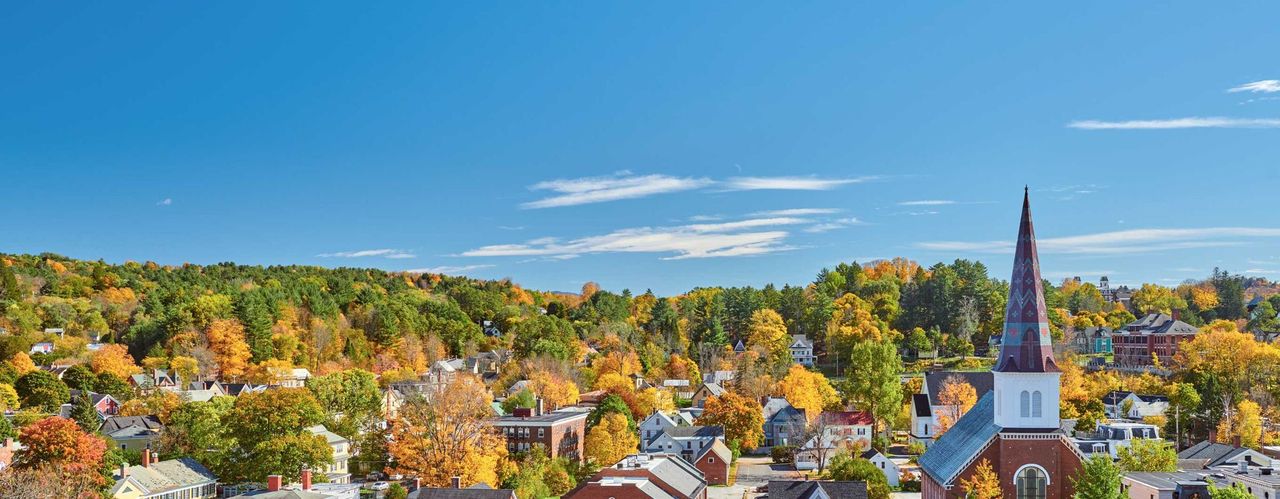
Homeowners Insurance in Vermont
Owning a home is an exciting step toward building your future. Whether you’ve settled in Burlington, Rutland, Milton, or anywhere in between, Vermont homeowners insurance could help protect your investment.
According to one report, experts predict more frequent heavy rainfall in the state, which could also bring stronger winds. A good home insurance policy could help cover the cost of repairs if your home is damaged by wind or other covered events.
This article will explain everything you need to know about Vermont home insurance, including its cost, factors affecting annual premiums, and more.
What is the average homeowners insurance cost in Vermont?
The average homeowners insurance in Vermont is $870 per year [1], which is 55% lower than the national average. However, your actual rate might be higher or lower based on factors like your home's value and age, the coverage you choose, and your claims history.
Curious about Vermont's average rates over the last five years?
The table below shows the state's average home insurance costs during that period. Keep in mind that these figures represent state-wide averages, not city-specific rates.
While state-level average homeowners insurance costs can provide a general idea, they often miss important city-specific differences. Urban areas tend to have higher premiums due to factors like dense populations, elevated property values, stricter building codes, and localized weather risks. To get a more accurate understanding of rates in your area, it's best to look at city-specific data or request quotes from local insurers.
Year | Average Premium [2] |
|---|---|
2025 | $870 |
2024 | $865 |
2023 | $1,263 |
2022 | $944 |
2021 | $1,025 |
The average homeowners insurance in Vermont is $870 per year, which is 55% lower than the national average.
What factors influence my home insurance rate?
The cost of homeowners insurance in Vermont depends on several key factors that insurance companies use to assess risk and set your rate.
Here are some of the most common ones:
- Location: Your home's state, ZIP code, and the area's insurance claims history could impact your annual insurance premium.
- Construction: The materials used to build your home affect its durability and repair costs. If you're building a custom home, you might need extra coverage for the construction site.
- Age of the house: Older homes might have outdated systems, which increases risk. Renovations and upgrades could help lower costs.
- Replacement cost: This is the estimated cost to fully rebuild your home in case of a total loss. An appraiser usually determines this value.
- Swimming pool: If your home has a pool, your liability coverage might need to increase to protect against potential injuries.
- Home-based business: Running a business from home could raise your premium since home insurance in VT might need to cover inventory, equipment, and supplies.
- Coverage level: The kind of insurance coverage you select, including personal property and liability protection, affects your overall premium.
Each factor helps determine your Vermont homeowners insurance rate, so understanding them could help you choose the right policy for your needs.
Common insurance discounts in Vermont
As a property owner in the Green Mountain State, you could save enough money on your home insurance in Vermont. Many insurance companies offer discounts, which help policyholders lower their premiums.
Since discounts vary by insurance company, it’s always better to review your policy annually. This could help you get the cheapest home insurance in Vermont.
That said, here are some common discounts you might qualify for:
- Bundling discount: If you insure your home and car with the same insurance company, you might receive a discount. Some insurers in Vermont extend this offer to other policies, such as motorcycle or renters insurance. Bundling could help simplify your insurance management and reduce costs.
- New home discount: Depending on your insurer, this insurance discount could apply differently. Some carriers offer discounts for newly constructed homes, as they typically have fewer maintenance issues and safety risks. Others might provide a deduction for first-time homebuyers as an incentive to secure suitable coverage.
- Claims-free discount: Homeowners who go multiple years without filing a claim might be rewarded with lower annual premiums. The timeframe for eligibility varies by insurer, but many require at least three to five years without claims.
- Affiliation discounts: Many homeowners insurance in VT provide discounts for policyholders in certain professions, such as teachers, nurses, and military personnel. Some insurance providers in Vermont even partner with universities to offer reduced rates to alumni groups.
- New roof discount: Since an old or damaged roof increases the likelihood of costly claims, insurance companies often reward homeowners who replace their roofs. Discounts might be even higher if you install storm-resistant materials to withstand severe weather.
Believe it or not, insurance companies often update their discount offerings. Therefore, you should check your policy annually.
If your house or personal situation changes, you might qualify for new savings. Talk to your insurance provider or agent about discounts to secure most affordable homeowners insurance in Vermont.
Tips for lowering home insurance rates
When your Vermont condo insurance or homeowners insurance is up for renewal, your premium might change due to factors such as inflation, claims history, or updated risk assessments. However, there are several strategies you could use to help keep your costs under control.
- Report home improvements: If you’ve upgraded your home, such as installing a new roof, storm-resistant windows, or a security system, let your insurer know. These improvements make your home safer and less prone to damage, which could qualify you for a lower rate.
- Ask about discounts: Your circumstances might have changed since you first signed up for your policy. If you have improved your credit score, switched jobs, or installed smart home security features, you might now qualify for new discounts. Long-term customers might also be eligible for loyalty discounts, so it’s worth asking your insurer what savings are available.
- Compare rates from other providers: Shop around because it could help you get the best homeowners insurance in Vermont. When you compare home insurance quotes in Vermont from multiple insurers, it could reveal more affordable options with similar or better coverage. If you find a lower rate elsewhere, you could use it to negotiate with your current provider or switch to a new insurer.
- Review your deductible: Increasing your deductible – the amount you pay out of pocket before your insurance comes in – could lower your premium. However, make sure to choose a deductible you can afford when you need to file a claim.
- Improve your credit score: In Vermont, insurers consider your credit-based insurance score when setting premiums. A higher credit score often leads to lower rates, while poor credit could result in higher costs. You could do a few things, such as pay bills on time, reduce debt, and keep credit card balances low to improve your score over time.
What does Vermont home insurance cover?
Home insurance in Vermont provides financial protection against unexpected events that could damage your home or personal belongings. While coverage varies by policy, most standard Vermont home insurance plans include the following:
- Dwelling coverage: This coverage policy – also called Coverage A – protects the structure of your home, including walls, roof, and foundation, against risks such as fire, windstorms, and falling trees. If a covered loss damages your house or property, your insurer will help pay for repairs or rebuilding.
- Other structures coverage: Also known as Coverage B, this includes detached structures on your property, such as garages, sheds, or fences. If these are damaged by a covered peril, your insurance could help cover repair costs.
- Personal property coverage: Your belongings, such as furniture, electronics, and clothing, are protected against damage or theft. If a fire, burglary, or other covered event destroys your possessions, your policy (Coverage C) could help replace them. Some high-value items, such as jewelry or artwork, might require additional coverage.
- Liability protection: If someone gets injured on your property and you’re found responsible, liability coverage (Coverage E) helps pay for medical expenses and legal fees. It also covers accidental damage you might cause to someone else’s property.
- Additional living expenses (ALE): If your home becomes unlivable due to a covered disaster, ALE coverage (Coverage D) helps pay for temporary housing, meals, and other necessary living expenses while repairs are made.
Remember, every coverage has limits and exclusions, so it’s best to review your policy regularly so you get the protection you need. If you want coverage that covers floods or earthquakes, you might need to purchase a separate policy (we’ll discuss this in the next section).
Additional Vermont insurance coverage options
Often, homeowners need additional protection (insurance riders or endorsements) beyond their standard home insurance. You could add coverage to your policy or purchase a separate policy.
If you dwell in Vermont, here are some options to consider:
- Flood insurance: Standard homeowners insurance in Vermont doesn’t cover flood damage. If you live in a flood-prone area, you might need to buy separate flood insurance. Keep in mind that most flood policies have a 30-day waiting period before coverage begins. Not sure if your home is at risk? You could check FEMA’s flood maps or the Street Foundation website for a better idea.
- Wind and hail damage: Most home insurance policies cover wind and hail damage, but they often have a separate deductible for these events. This deductible is usually between 1% and 5% of your dwelling coverage. For example, if your home is insured for $250,000 and your wind deductible is 1%, you’ll have to pay $2,500 before your insurance covers the rest.
- Landslides: Vermont’s hilly landscape and heavy rainfall could lead to landslides, which might put your home at risk. Unfortunately, most standard homeowners policies don’t cover landslides. You’ll likely need to buy an additional policy or endorsement for protection.
- Wildfires: Your home insurance typically covers fire damage. However, it’s important to check your policy for exclusions. Pay close attention to your dwelling coverage limit, the maximum amount your insurer would pay to rebuild your home. Make sure you have enough coverage to fully rebuild if needed.
- Umbrella policy: The umbrella insurance helps provide extra liability coverage beyond your homeowner's policy, protecting your assets if you exceed your policy limits.
- Sump pump & water backup coverage: Standard policies don’t usually cover sewage backups or sump pump overflows. Add this optional coverage to help protect you in case of heavy storms.
What coverage is recommended in Vermont?
Vermont homeowners face unique risks due to the state's geography and climate. While a standard home insurance policy covers many common perils, additional coverage options could provide extra protection.
Here are the key types of insurance recommended in Vermont:
- Flood insurance: Standard homeowners insurance won’t cover flood damage, which could be a significant risk in Vermont. The state’s mountainous terrain makes river flooding a common issue, and heavy rain from hurricanes could also lead to flash floods. Flooding could still occur if your home is outside a designated flood zone. Purchasing a separate flood insurance policy through the National Flood Insurance Program (NFIP) or a private insurer is highly recommended.
- Extended replacement cost coverage: Construction costs could fluctuate due to inflation, labor shortages, and material price increases. If your home is damaged or destroyed, extended replacement cost coverage covers rebuilding costs even if they exceed your initial coverage limit. This helps homeowners avoid unexpected out-of-pocket expenses.
- Earthquake insurance: Although earthquakes are uncommon in Vermont, they occur. Standard homeowners insurance doesn’t cover earthquake damage, so purchasing earthquake insurance could provide valuable financial protection if an event were to cause structural damage to your home.
- Windstorm coverage: While Vermont is not a coastal state, strong winds from storms and hurricanes could still cause significant damage. Windstorm coverage protects against damage from high winds, falling trees, and debris, ensuring your home is safeguarded against severe weather events.
Insuring your home in Vermont
Looking to buy home insurance in Vermont? The process to insure your Vermont home is rather easy and usually includes the following steps:
- Assess your coverage needs: Evaluate the value of your home and personal belongings to determine the coverage levels. Consider the home's age, construction materials, and unique features.
- Research insurance providers: Look for reputable insurance companies that provide homeowners insurance in Vermont. Compare their rates based on coverage options being offered, customer reviews, and financial stability.
- Obtain multiple quotes: Request quotes from several insurers to compare premiums and coverage details. This would help you identify the value for your specific needs.
- Review policy details: Carefully read through the terms and conditions of each policy. Pay attention to coverage limits, exclusions, deductibles, and any additional endorsements necessary for your situation.
- Finalize your policy: Once you've selected a policy that fits your needs and budget, work with the insurance provider to finalize the most suitable coverage. Understand the claims process and have all necessary documentation.
Is Vermont homeowners insurance required by law?
Vermont law doesn’t mandate homeowners to carry insurance on their property. However, if your home is financed through a mortgage, lenders typically require insurance coverage to protect their investment.
Even without a mortgage, homeowners insurance is a prudent decision to shield yourself from potential financial hardships resulting from property damage or liability claims.
Looking for homeowners insurance in a different state?
If you need homeowners insurance outside of Vermont, check out our state-by-state guide:
Still have questions?
Is Vermont an expensive state?
Vermont's cost of living is slightly higher than the national average, influenced by factors like housing, healthcare, and groceries. However, many residents find the quality of life, natural beauty, and community atmosphere worth the cost.
What is the cost of living in Vermont for one person?
The cost of living for a single individual in Vermont varies based on lifestyle and location within the state. Housing, utilities, transportation, and food expenses could be around $68,712 per year.
Is Vermont prone to earthquakes?
While Vermont is not known for frequent seismic activity, it has experienced minor earthquakes. The risk is relatively low compared to states such as California, but it's still advisable to be informed and prepared.
How much is homeowners insurance in Burlington, VT?
Homeowners insurance premiums in Burlington, Vermont, depend on various factors, including the home's value, coverage levels, and the insurer. On average, residents pay approximately $835 annually. Obtaining personalized quotes from multiple providers would give you the most accurate estimate.
How much is Vermont condo insurance?
Condo insurance in Vermont, also known as an HO-6 policy, typically costs $255 per year. The premium depends on coverage specifics, the value of personal property, and the building's location.
Sources
[1] - Information from NerdWallet
[2] - Information from III, Gethomeinsurancequotes.com, ValuePenguin, Policy Genius, Nerd Wallet
Figures reflect averages from publicly available sources as of March, 2025.
This article is for informational purposes only and was compiled from sources not affiliated with Hippo. While we believe this information to be reliable, we do not guarantee its accuracy or completeness. For any insurance-related decision, please consult your licensed insurance producer.



